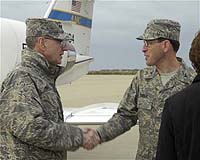| . |  |
. |
Sunnyvale CA (SPX) Sep 21, 2009 Lockheed Martin has begun thermal vacuum testing of the first Space Based Infrared System (SBIRS) geosynchronous (GEO-1) satellite, a major program milestone that will validate spacecraft performance in a complete test-like-you-fly environment. The U.S. Air Force's SBIRS program is designed to provide early warning of missile launches, and simultaneously support other missions, including missile defense, technical intelligence and battlespace awareness. Conducted inside Lockheed Martin's Dual Entry Large Thermal Altitude (DELTA) chamber, the test will verify spacecraft functionality and performance in a vacuum environment where the satellite is stressed at the extreme hot and cold temperatures it will experience in space. The extensive test is designed to validate the overall satellite design, quality and workmanship and survivability during space vehicle launching and on-orbit operations. "The entire team has worked extremely hard throughout our rigorous process of risk reduction and subsystem and baseline testing leading up to this critical test," said Dave Sheridan, Lockheed Martin's SBIRS GEO program director. "We look forward to executing a disciplined and thorough test and delivering this revolutionary satellite that provides vastly improved surveillance capabilities for the warfighter." The SBIRS team is led by the Space Based Infrared Systems Wing at the U.S. Air Force Space and Missile Systems Center, Los Angeles Air Force Base, Calif. Lockheed Martin Space Systems Company, Sunnyvale, Calif., is the SBIRS prime contractor, with Northrop Grumman Electronic Systems, Azusa, Calif., as the payload integrator. Air Force Space Command operates the SBIRS system. The team is executing to a planned schedule that supports GEO-1 delivery and launch in the beginning of fiscal year 2011 aboard an Atlas V launch vehicle. Lockheed Martin's SBIRS contract includes the two highly elliptical orbit (HEO) payloads now on-orbit, two geosynchronous orbit (GEO) satellites, as well as ground-based assets to receive and process the infrared data. The team was recently awarded a $1.5-billion contract for the third HEO payload, the third GEO satellite and associated ground modifications. A contract to include a fourth HEO payload and potential fourth GEO satellite is expected to be awarded later this year. Share This Article With Planet Earth
Related Links Lockheed Martin Military Space News at SpaceWar.com
 AFSPC Commander Discusses Space, Cyberspace Future
AFSPC Commander Discusses Space, Cyberspace FutureWashington DC (AFNS) Sep 18, 2009 The Air Force's lead for integrating space and cyberspace capabilities spoke at the 2009 Annual Air Force Association Air and Space Conference and Technology Exposition at the National Harbor, Oxon Hill, Md., Sept. 15. Gen. C. Robert Kehler, commander of the 43,000-member Air Force Space Command, addressed strategic deterrence in space and cyberspace before attendees that included civilian ... read more |
|
| The content herein, unless otherwise known to be public domain, are Copyright 1995-2009 - SpaceDaily. AFP and UPI Wire Stories are copyright Agence France-Presse and United Press International. ESA Portal Reports are copyright European Space Agency. All NASA sourced material is public domain. Additional copyrights may apply in whole or part to other bona fide parties. Advertising does not imply endorsement,agreement or approval of any opinions, statements or information provided by SpaceDaily on any Web page published or hosted by SpaceDaily. Privacy Statement |